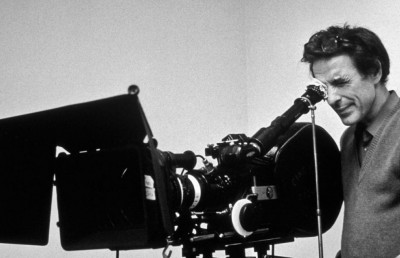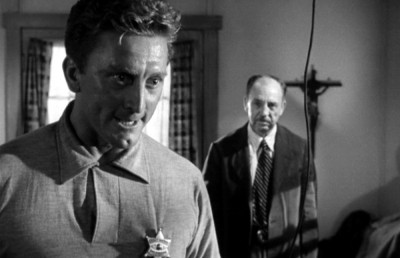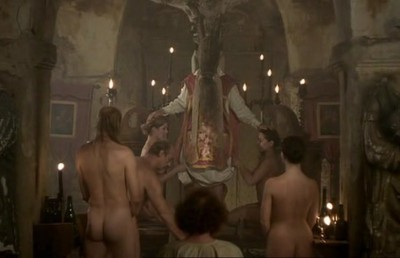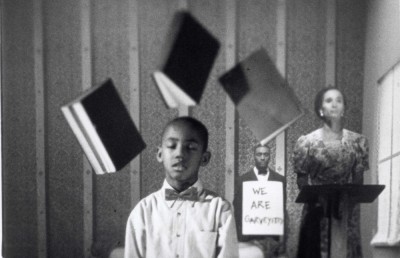Mirroring History: Fassbinder’s The BRD Trilogy
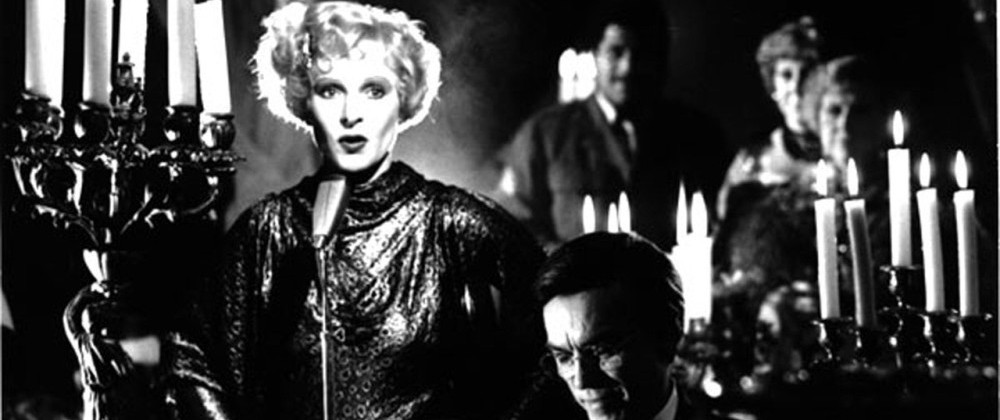
[H]ysterics, mourners, and melancholics are all people who remember too much. Specialists in the past, they are consummate historians. Yet only the mourner gets it right. [1]
Rainer Werner Fassbinder shares with many of his contemporary New German cineastes the romantic pessimism about the quest for love and freedom, which gets thwarted by individual limitations and the circumstantial wickedness of society. But, in dealing with the post-war ‘inability to mourn’, Fassbinder is one of the least apologetic filmmakers of the New German Cinema. Although critical of trauerarbeit, he falls neither in the realm of narcissistic self-pity (e.g. Volker Schlondorff’s Tin Drum (1979) or Sander Brahms’ Germany, Pale Mother 1980) nor in the domain of schizophrenic self-justification (as in Syberberg’s Our Hitler, 1978). Instead—as Elsaesser notes, Fassbinder treats German history and fascism “in relation to the present, and its representation across the dialectics of identification, the splitting and doubling of the self.” [2] The BRD Trilogy (Marriage of Maria Braun (1978), Lola (1981), and The Longing of Veronika Voss (1982)) continues in the tradition of Ali, Fear Eats the Soul (1973) and The Merchant of Four Seasons (1972), to interview, and not judge, the Federal Republic of Germany in Adenauer’s era.
The trilogy films are highly stylized and classically narrated melodramas about Maria Braun (Hanna Schygulla), Veronica Voss (Rosel Zech) and Lola (Barbara Sukowa) who represent women in an antagonistic interaction with a patriarchal society. The main characters of each film have in common the persona of a somewhat femme-fatale woman, trapped by her desire for emotional (like Maria Braun), financial (like Lola) and psychological (as in case of Veronika Voss) emancipation. The narratives revolve around the ambivalence of love, with women caught in a corrupt man’s world, and in quest of their post-war socio-economic place. Typically, the road to success for these women in the Fassbinder-depicted patriarchal society, is paved by their mastery of seduction and betrayal (of men). The stories are told against the backdrop of the “economic miracle” which functions as a historical motif, and shapes the characters’ persona and motives, thus driving the causal (melodramatic) relationships between the women and the society to which they belong. Classically narrated as a ‘Sirkian’ melodrama, with lavish lighting and costumes, The Marriage of Maria Braun, Veronika Voss and Lola lend themselves to a conventional reading of a linearly constructed story about the rise and fall of a character; characters with personal histories and individual dramas in a given historical moment.
The exaggerated stylization of the films (especially in acting, colors, costumes, and lighting) also serves as a distanciating device that takes the stories beyond the realm of personal into the possible allegorical reading of the anxiety of the post-war Germany as a nation in a dubious historical stance during the 50s. As Elsaesser notes, the BRD Trilogy is a fulcrum for Fassbinder’s thinking about German history, prompting the thought that for Fassbinder the decade (50’s) was a “metaphor for the different cycles of new beginnings that had marked the new German history, or more a metonymy, where the decade could stand as a part for the whole, or even the fast tracked replay of Germany’s entire modern development after total destruction, best described by the Marxian motto that history always repeats itself, once as tragedy, the second time as farce …” [3]
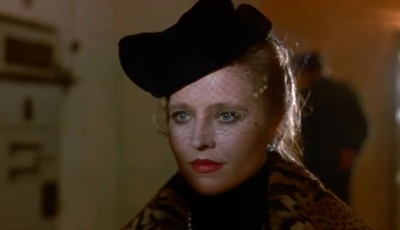
Hanna Schygulla as Maria Braun
The stories of the BRD Trilogy (“BRD” stands for Bundesrepublik Deutschland, which is the official name of West Germany) spans the periods of American occupation, Konrad Chancellor Adenauer’s era of the Federal Republic of Germany, and the miraculous recovery of the West German economy (Konrad Adenauer being the first Chancellor of post-war Germany/West Germany, from 1949-1963, who helped guide Germany through its economic miracle). This era began at the Postdam conference (July 17-August 2, 1945), where three Heads of Government of the U. S. S. R., the U. S. A., and the U. K. drafted the principles to govern the treatment of Germany under total occupation in the initial control period. The purpose of the occupation was stated as total destruction of the industrial war machine, complete abolishing of the militarism and Nazism and convincing the German people that they had suffered a total military defeat and that they were responsible for what they brought upon themselves, since their own ruthless warfare and the fanatical Nazi resistance had destroyed German economy and made chaos and suffering inevitable.” [4] A Joint Chief of Staff (JCS 1067) directive given to General Eisenhower reiterated these aims of occupation and went so far as to forbid fraternization with the German population and to prohibit giving the Germans food beyond the minimum requirements necessary to prevent famine and starvation. [5] Given the tight leash of the JCS 1067 directive, the economic miracle in West Germany came at the wake of the Cold War, and at the price of setting the foundations of their infantile democracy on Adenauer’s autocratic manner of government, losing the eastern zone to unquestionable control of Russia, rearmament in compliance with the demands of occupying forces, and reinstating many a Nazi officials within the governing bodies of the Federal Republic.
Ironically, the Federal Republic of Germany sprouted through the widening gap between the communist Russia (who conquered Berlin) and the capitalist Western Allies (who claimed the victory). In 1948, ideological phobia split the Western and the Soviet parties; disagreements over control of Ruhr culminated into Russia leaving the Control Council; and, in a few days, Russians began the blockade of Berlin. This event brought to public view the hostile rift between the old allies (Russia versus France, USA and UK) and eventually it ended in a formation of alliance between the old enemies. Germany was warmly embraced by the United States to the extent that the increasing rancor of West’s denunciation of the Soviet Union gave the Nazis a sense of justification for having been the first to warn against the perilous outcome of Bolshevism. [6] The push for the creation of West Germany came from abroad, especially from the Americans; and the Germans—although ambivalent about the unity of their country—immediately realized the economic opportunities of the Marshall plan that also guaranteed the political support from the United States. As such, they set up a ‘provisional’ Constituent Assembly on July 1st 1948, and to draw a ‘Basic Law,’ which was completed in spring of 1949. [7] Under the terms of the Basic Law an election was held; a coalition government between Christian Democrat Union (CDU), the Free Democrats and the German Party was formed; and Adenauer with majority of one vote was chosen as federal chancellor. The United States, Great Britain and France formally recognized the Federal Republic; however, in a revised Occupation Statute, they reserved to the occupying forces the power over disarmament, demilitarization, reparations, industrial controls in the Ruhr, foreign affairs and foreign trade, displaced persons and refugees, and the protection of Allied forces and their families. The wall that cut through Germany and broke its heart, Berlin, also split the national psyche of the German people into a schizoid of conscience versus reality. Partitioned and lacking sovereignty, guilty of abandoning the Eastern zone, West Germany took comfort from active economic support of United States, given in exchange for their opposition to archrival, the Eastern Block.
Similarly to the dichotomous dynamics that created West German history, the narratives of the BRD trilogy take shape from dialectical interrelations between assumed moralities and existing realities that consume the characters (or a nation) within paradoxical periods of history. Fassbinder’s trilogy juxtaposes the hunger years in Maria Braun with the plenteous days of the economic recovery in Lola, and uses Veronika Voss to draw a psychological trajectory between the contrasting features of German history. In fact, the passage from the convictions of Maria Braun and the longing of Veronica Voss, to the pragmatic Lola, parallels a passage from melancholia and mourning (the objects of remembrance) to action towards reconstruction of new—and not necessarily more promising—realities.
The Marriage of Maria Braun portrays the end of the war, the early years of occupation, the hunger years of Germany under JCS 1067. The movie opens on Hitler’s photo. An explosion knocks the picture off the wall of the civic center and the blast leaves a hole through which the camera peeps at the wedding ceremony of Maria and Hermann (Klaus Lowitsch).
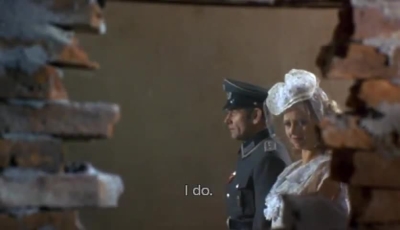
The newlyweds spend half a day and a whole night together before Hermann heads to the frontline. In the absence of men—her father, husband and brother-in-law—Maria trades her wedding dress and her father’s souvenirs on the black market for fire lumber, a piece of bacon and four potatoes: which represents a treat for her mother during life under occupation. At the end of the war, having lost faith in her husband’s return, Maria trades her body to American soldiers in order to feed her family (and to keep herself warm in bed, as her friend advises her.) Upon the unexpected return of her husband, Maria kills her black American boyfriend, and in return for her loyalty, Hermann assumes the guilt and receives a jail sentence. To build a life for Hermann and herself, Maria resorts again to her feminine asset of seduction and by luck, falls in the hands of Oswald (Ivan Desney), an industrialist (presumably Jewish, who had spent the Nazi years abroad.) From this point on, Maria rides the waves of economic miracle on board Oswald’s ship of success. At the end, however, Maria’s dream of reuniting with her husband comes to a fatal end as she learns that while she was selling herself to Oswald—and abstaining from falling in love with him as she was preserving herself for Hermann—to build a future for her husband, Hermann was selling her to Oswald in order to double their financial future by inheriting the rest of Oswald’s state.
The hunger of Maria Braun and her family, the craving for cigarettes, the soaking of bread in water, or the exchange of a family brooch for prostitution garb are narrative examples that document life in Germany under occupation, which according to a German journalist, was reduced to the reality of “the ration of bread and margarine that one drew, or failed to draw; the black market where if you failed to get away with it, you went under … the daughter who went with the “Yankees” to provide food for the family …the fear of punishment or arrest, fear of Russians, fear of simply perishing ….” [8] In that era, as Abosch observed, “[d]efeat had left [the Germans] with one profound conviction: a complete distrust of all ideologies. For them the big words like People, Race, Destiny had a hollow ring; … Having rejected ideas, they sought to live on a diet of facts….” [9] It is in this era that Maria asks her doctor for a health certificate to join an American brothel; the era of accepting that “it’s a bad time for emotions but it is better that way; nothing can hurt you.” It is in the escapist atmosphere that surrounds defeat, in intolerance for the burden of thoughts, that Maria’s cold pursuit of material prosperity signifies Germany’s post-war urge to acquire wealth. From this perspective, The Marriage of Maria Braun can be considered quite literally an historical film that recounts the psychosocial mood of Germany during early years of occupation, illustrating the psycho-economic dynamics that aided the rise of German economy from its state of total collapse.
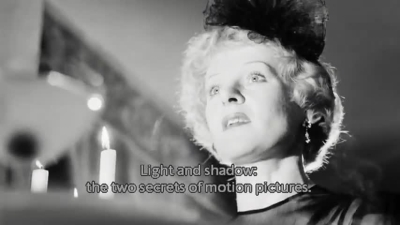
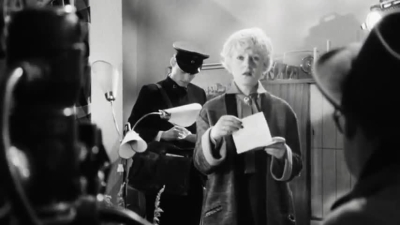
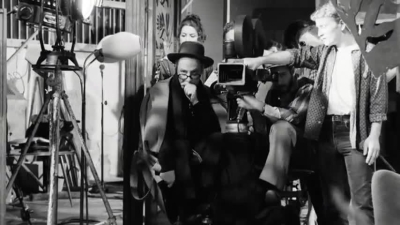
Reflexivity in Veronika Voss
The second part of the trilogy, Veronika Voss, is formally more complex and self-reflexive than the other two films. It is filmed in black and white; constructed non-linearly and layered around multiple axes of time and meaning. Made in 1981, the film represents Germany’s past (1955) in the form of a film-noir, which was the popular form of American post-war cinema. By means of flashbacks into the memory of Veronika Voss, it also reflects upon the cinematic mood and the cultural style of the UFA studios in the mid 30s era; an important instrument in the hands of Hitler’s propagandist in chief, Goebbels. Unlike Maria Braun and Lola, this film does not make direct references to the economic and political situations in Germany in the 50s. Rather, it focuses on memory and the power of the image in formation of a nation’s history.
The story of Veronika Voss takes place in 1955. The introductory sequence opens on Veronika Voss as she is sitting next to Fassbinder himself in a movie theater, and is watching one of her (presumably) earlier performances in the “Insidious Poison,” a UFA production. The camera then cuts from a disturbed Veronika Voss in the spectator’s seat to her character on the cinema screen, where she begs a doctor to make her pain go away in exchange for everything that she possesses. As she signs the contract and receives the doctor’s injection (painkiller) (in Insidious Poison), the movie (Veronika Voss) cuts to a glittering shot of Veronika’s memory of the shooting day of that particular scene in “Insidious Poison,” where she tells the doctor: “Now you have everything, all that remains to give you is my dreams. I am not interested in your cheap dream,” the doctor responds. The take finishes successfully and Veronika proudly walks to her screen-writer husband who congratulates her perfromance. And then we cut back to Veronika in Veronika Voss who seems disturbed and leaves the movie theater. In next shot, as she walks in heavy rain, a sports reporter, Robert Krohn (Hilmar Thate), offers her an umbrella and, without knowing who she is, falls under her spell and gets dragged into a chain of intrigue that leads to Dr. Katz (Anne-Amrie Duringer)—a psychiatrist under protection of public health department and an American GI, who supplies her patients with addicting doses of morphine to treat their “vague” psychosomatic pains.

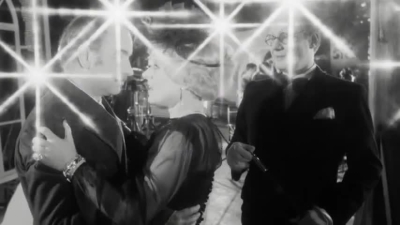
The anachronism of the narrative in the first sequence provokes an important discourse: it sets up the theme of memory which is associated with melancholia and longing for a bygone past, but it also draws attention to the recycling of the fictitious pictures—made by the German ‘dream factory’, UFA—and their projection into the reality of life. While consumed by the pain of longing for her glamorous past, Veronika lives a present that disturbingly resembles the life of her past’s on-screen characters. The uncanny parallelism between Veronika’s fictive portrait in “Insidious Poison” and her life in Veronika Voss functions as a critique of the significance of representation in the formation of history, by holding a fictitious image that disguises as a mirror of the present or future realities; and by seeking identity in the virtual images of the past. Thus memory and representation in Veronika Voss operate in a bidirectional—and in this case, perpetually destructive—relationship. Presenting someone an image of his or her self-destruction, while replicating it in a mirror invokes tremendous anxiety. In Veronika Voss, Fassbinder presents an image of national anxiety in the year 1955 as Germans looked in the mirror of Adenauer’s longing for a glorious past which appeared to become a possibility in the prospect of rearmament, as the Western powers were beginning to realize the importance of a strong Germany to shield them from the infiltration of communism. The thought of rearmament revived the harsh realities of the war and the occupation years whose shame, horror and pain still devoured many of those who had sought refuge in the opiate of the economic miracle.
In a historical context, on May 9, 1955, ten years after the end of the WW2 (on May 8, 1945), the German flag was raised for the first time in Paris, and in an official ceremony, the Federal Republic of Germany joined the North Atlantic Treaty Organization (NATO). In response to the welcoming remarks of 16 foreign ministers, Adenauer stated: “The German people have paid harshly for the horrors which were committed in their name by evil leadership and have paid these horrors with unlimited suffering. …Today, everywhere in Germany, peace and freedom are felt to be the greatest treasures as was true in the best periods of her history.” Despite Adenauer’s enthusiasm for a return to the community of nations, more than 62 percent of Germans were opposed to military involvement of Germany in defense of Europe against Soviet attack. [10] Nevertheless, the polls in May 1955 showed a marginal split between those favoring and opposing rearmament, with the majority of the opponents of the army being women. [11] Although in Adenauer’s vision, forming alliance with Western powers was aimed at gaining political power that would ease the negotiations with the Soviet Union for reunification of Germany, his policy was also scrutinized for its submissive attitude towards the American expectations and polarizing the country against the eastern block, and in a way, betraying Eastern Germany. [12]
In such a context, the business of Marian Katz in association with the black American GI, the governmental health official, and her patients who seek a passive tranquility from their past, represent the complicity of the Adenauer’s Germany in alienation of those seeking political truth: in this case journalist Robert and his victimized girlfriend. The background jazz music, the badly mannered American GI (a body guard, a drug dealer?) and the casualty with which he conducted himself in Marianne’s house, the English radio and Veronika’s dream of emancipation in Hollywood and the American “dream factory” also comment on the extent of American cultural and political influence in Germany; these elements mirror parallels between the UFA’s dream factory maneuvered by the political ambitions of the Third Reich and America’s Trojan horse in a cultural war for world dominance, Hollywood.
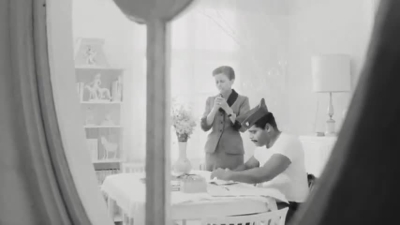
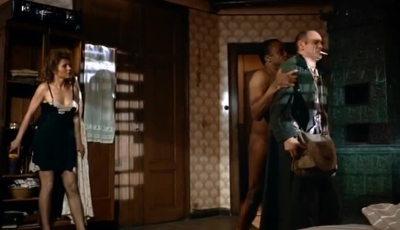
Black GIs in Veronika Voss and The Marriage of Mara Braun
The final film of the Trilogy, Lola serves as a metaphor for Germany in a subjective state of moral hypocrisy and capitalist opportunism and in a struggle to find her objective place back in the world community. In contrast to Veronika Voss, Lola??’s Germany is not concerned with the past, nor critical about the morality of the economic choices that need to be made. The movie opens on a still shot of Adenauer, in a pose that communicates a content but reflexive mood. Lola, her mother and her fatherless child are from East Prussia. Lola is the wealthy star-whore of the town (or a singer as she introduces herself) but her mother, who takes care of her child, refuses to accept money from Lola and insists on working as a housekeeper for the charismatic head of the planning and building department, von Bohm (Armin Muller-Stahl). He loves children, is courteous to women and has a fine taste for culture. Lola interplays between Schukert (Mario Adorf)—the rich and powerful contractor, and von Bohm, not only seeking her financial independence and social status, but also acting as a catalyst in economical relationships between Schukert and von Bohm. On the surface, ??Lola deals with the issues of reconstruction under Marshall plan, with the social problems of refugees who sought economic asylum in the booming West Germany, with coming to terms with democracy and the leftist protests against rearmament and the capitalist expansion of what was coined as ‘socialist economy’. In Lola, the mayor, the investor, the police, the civil servant and the whole governing body of the city lead a nocturnal life, which bonds their relationships together and forms the chains of actions that they pursue in their daily duties. Nevertheless, denunciation of corruption is not the subject of the film’s critique.
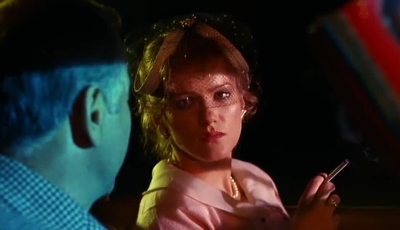
Fassbinder protégée Barbara Sukowa as Lola
According to Elsaesser, in Lola, the issue of corruption and moral hypocrisy which appears to typify the West Germany of the economic miracle is a complicated matter, since the characters in Lola “manifest to varying degrees and on varying occasions a particular brand of insight and acuity which makes Lola one of the wittiest, sharpest but also most sardonic post-war German films altogether.” [13] The historical backdrop of Lola is intelligent “compromise,” and in some ways, von Bohm’s autocratic character embodies Adenauer’s ambivalent legacy.
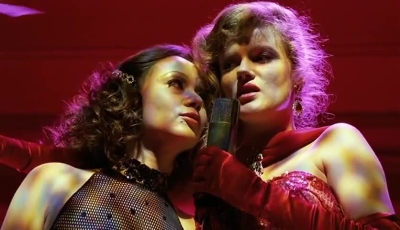
The seductive Lola
As Von Bohm arrives in his office, he realizes a lack of discipline, which immediately irritates him, so much so that he yells at his secretary and informs her that the course of business in the office needs to change: “I want to make a new beginning, a new beginning!” In the first meeting with the city authorities, he sets the objectives of his mission: “ the construction of this city, ladies and gentlemen, will not be complete for some time. The wounds opened in our community by the war have yet to heal. … but we can already see newer, wider-reaching tasks. The economic marker of our social market economy has unleashed forces that go beyond the old ways, literally creating new ground. We, the planning department and the building office, (and here the Mayor and Schukert look concerned) have the task of supporting these expansive forces. This country, here and now, requires from us reconstruction and expansion. That is the mission that will guide us. We must do our best to allow progress to move forward for the benefit of all.” However, the mayor immediately (and privately) reminds him that “ the mid-level civil servant needs a director who tells him ‘I know how to interpret laws narrow-mindedly, you show me how to make use of them generously’ … we are all in agreement over the sense of duty. Seeing the big picture and not getting lost in fine prints is what we need so badly.” With these statements, it appears as if Fassbinder is rehearsing Adenauer’s indoctrinations. Aside from the ‘social market economy’, which was under left-wing attack, Adenauer’s greatest criticism was his tolerance and moderation towards ex-Nazis; the fine print which he overlooked in his vision of looking forward to rebuilding Germany.
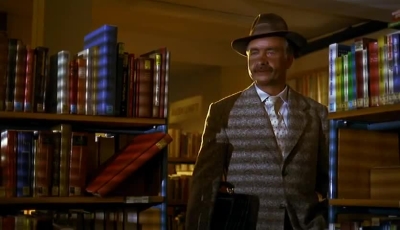
Noir lighting in Lola -with Armin Mueller-Stahl
Two of the most publicized instances of Adenauer’s bureaucratic generosity were appointing Dr. Hans Globke—who had written the legal commentaries to the anti-Semitic racial laws approved by Nazi Party—and professor Theodor Oberlander—who had held high academic and administrative posts under the Nazis. [14] In the early 1950s Oberlander joined the Refugee Party, under chairmanship of Herr Waldemar Kraft, a former member of Hitler’s SS. [15] In 1953, both Oberlander and Kraft were invited by Adenauer to join the coalition government. Oberlander held the ministry of refugees until 1960. [16] Globke, on the other hand, was appointed as the secretary of state, the second most powerful man in the government after Adenauer himself. [17] In spite of harsh criticism, however, Adenauer’s choice of former Nazis for high governmental positions was rooted in his political vision for the Federal Republic. Globke, a conscientious and efficient civil servant with an extraordinary memory was indispensable to Adenauer’s large Federal Chancellor’s Office, which consisted of many senior civil servants under State-secretary Globke, and helped Adenauer exercise supervision over every ministry in implementation of his Basic Laws. [18] On the other hand, appointing former Nazis such as Kraft and Oberlander in the cabinet not only absorbed members of the refugees party (All-German Bloc/League of Expellees and Deprived of Rights) into his coalition government, but also helped prevent the emergence of right-wing parties that fed off the sympathy people felt for the perceived Nuremberg mistrials (based on the belief that there were no Germans or neutrals represented amongst the judges and minor offenders were often treated with greater severity than the more serious cases). [19] Thus Adenauer’s policy of studied moderation and the exaggerated fairness of the civil service law made it possible for this sympathy to die a natural death.
It is in light of such historical facts that an allegorical reading of the Lola becomes possible and as Elsaesser states: “The logic of Lola implies that it becomes a matter of political intelligence—even from the point of view of democracy, and not only out of expediency or cynicism—for Von Bohm, to eventually comprehend that the purpose of his job … cannot be to ‘go all out and ruin’ property tycoon and his local power cartel.” Therefore, Lola is not the story of a morally upright person seduced into success by money, sex and power, nor is it the story of arrogant moral superiority that meets its just desert. According to Elsaesser, such interpretations lack intelligence and assume a moral superiority and political judgment that irritated Fassbinder. Rather, Lola asks why the West German society was “so successful in becoming both a leading capitalist power and a consensus democracy, when by rights it should not have been either, given the provincialism, the venality and hypocrisy, the lack of public spirit when it came to confronting the past, and finally, the hypochondria and self-pity usually ascribed to West Germans?” [20]
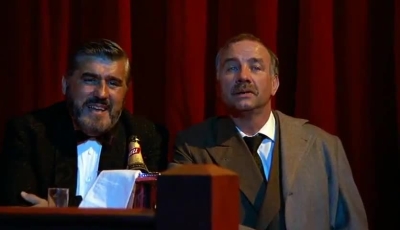
Italian actor Mario Ardof with Mueller-Stahl
The films of the BRD Trilogy overlap in characters, motifs, themes, and setting. In all three, the films present a tragic, comic, ironic or grotesque spectacle of fetishistic phallic power, which is tied to German history. [21] In all three films, the women use their male lovers as stepping stones towards their goals, using commitment as a commodity to be liquidated, a currency for independence. Maria Braun trades her marriage vows to prostitution at a GI club; trades love for the black American soldier, Bill, for wood and wine; trades Bill’s life with her loyalty to her returning husband, trades sex with Oswald for economic gain. Veronika Voss, similarly, sells her affection in exchange for drug money, while having already mortgaged her life and her possessions to the morphine shots given to her by her psychiatrist, Dr Marianne Katz. The sport journalist’s fetishistic relationship with Veronika costs his girlfriend’s life, as she was trying to help him gather evidence of Dr Katz’ drug business. When he tries to uncover the murder of his girlfriend, and brings the police to the room where Veronika is kept, she denies having known him and laughs at his romantic disillusionment about their relationship. Lola plays off three men, the cynical clerk Esslin, the opportunistic developer Schukert and the idealist bureaucrat Von Bohm. Explicit in her price, and without any moral pretension, she trades her sexual powers to claim her space—even though as ill regarded as a brothel—in the recovering economy of the Federal Republic. Lola, thus, appears to be the least dubious character of all three women of the Trilogy.
In spite of their treacherousness, however, Maria and Veronika display certain traces of idealism and romanticism that is much fainter in characters that populate Lola. Maria guards a sacred temple for her ideal of love and marriage, symbolizing it with her determination to block her feelings for other men. She makes no claims about her nobility, or her loyalties to anyone other than her husband. She confesses to be “a master of deceit: a capitalist tool by day, and by night an agent of the proletarian masses—the Mata Hari of the Economic Miracle,” yet she insists that ‘love’ is a good feeling, real and true and although in action, she succumbs to the reality of the material world, she refuses to believe her friend Vevi that: “The only thing true is an empty stomach. And feelings are something you have between your legs, like an itch.”
Veronika is entrapped in a romantic longing for the glory of her past and unable to separate herself from the desire for perfection and fame in the spotlight. The doom that the characters of Veronika Voss experience is also rooted in the disillusionment of idealism. Robert, the sports reporter tries in vain to confront the established corruption and save his subject of fetish. The Jewish couple—the victims of the Nazi past—similar to Veronica Voss—the starlet of the Nazi past—share the inability to come to terms with their memories and form a cult of worship for Dr Katz—who in conspiracy with a GI soldier and the health ministry officials drains them of their material possession, in exchange for euphoria of forgetfulness. As the ideological numbness and romantic disillusionment of Maria and Hermann, or chemical tranquilizers of Veronika and the Jewish couple wear off, the stark pain of reality leads to such a confusion in the minds of Maria and Veronika that it is hard to judge whether they ended their lives deliberately or accidentally.
Lola does not suffer such fate. She is neither romanticist, nor idealist. When Esslin reads her a sad poem, she asks for a funny poem; and when Esslin claims that the poetry is sad because it comes from the soul which knows more than the mind, she states that to her, it is the other way around; that mind knows more than soul. Her love for Von Bohm is a mere seduction; she does not have any disillusionment about her role in the society as a whore. Yet she bets her boss, Schukert, that she can be the woman for a ‘modern’ and ‘old-fashioned’ moralist, in spite of her contempt for the concepts of ‘modern’ and ‘old-fashion’. Lola, similar to Maria and Veronika, accepts the corrupt reality that surrounds her, but unlike them, does not take refuge in her private world of ideals or memories. When Esslin asks whether she wants to live in a city consumed by corruption and immorality, Lola responds: “Gladly, only they don’t let me join in.”
Perhaps, Fassbinder’s answer to “how is it that a society like Federal Republic of Germany works?” comes from Lola. While she sits in front of a mirror—a salient motif in all three films—Lola does not long for an unfulfilled dream—as does Maria—nor for a glorious past long gone—as does Veronika. The mirror in which Lola looks is a device that helps her to make up her face and comb her hair, features to sell at a high price in the social market economy of the brothel. If we take the mirror to be an allegory for Germany’s self examination and revision of its history, then Lola’s liveliness and exuberance as she sets her price to be Schukert’s mistress on her wedding day, in contrast to death of Maria Braun and Veronika Voss at the end of the films, summarizes the miraculous recovery of West Germany not only from the ashes of the lean years, but also from the smoke of self-pity, and the fog of idealistic megalomania.
Endnotes
1 Caryl Flinn. New German Cinema, Music, History And The Matter Of Style, p.55.
2 Thomas Elsaesser. New German Cinema, A History. p. 267
3 Thomas Elsaesser. Fassbinder’s Germany, p.111
4 A Decade of American Foreign Policy: Basic Documents, 1941-49. Prepared at the request of the Senate Committee on Foreign Relations By the Staff of the Committee and the Department of State. Washington, DC: Government Printing Office, 1950. Available here.
5 The governing directive corresponding to German Standard of Living in JSC 1067 states: “You will estimate requirements of supplies necessary to prevent starvation or widespread disease or such civil unrest as would endanger the occupying forces. Such estimates will be based upon a program whereby the Germans are made responsible for providing for themselves, out of their own work and resources. You will take all practicable economic and police measures to assure that German resources are fully utilized and consumption held to the minimum in order that imports may be strictly limited and that surpluses may be made available for the occupying forces and displaced persons and United Nations prisoners of war, and for reparation. You will take no action that would tend to support basic living standards in Germany on a higher level than that existing in any one of the neighboring United Nations and you will take appropriate measures to ensure that basic living standards of the German people are not higher than those existing in any one of the neighboring United Nations when such measures will contribute to raising the standards of any such nation.”
6 Heinz Abosch. The Menace Of The Miracle, p. 22
7 Richard Hiscock. Germany Revived, p.31
8 Heinz Abosch, p. 4
9 Ibid, p. 10.
10 Karl Deusche and Lewis Edinger. Germany Rejoins the Powers, p. 26.
11 Ibid, p. 30.
12 In the Menace of the Miracle, Heinz Abosch writes: “While Adenauer has constantly succeeded in consolidating his position at home, he has enjoyed an even greater reputation abroad (in the west …). His unwavering support for western policy, his chronic refusal to examine any Soviet proposal seriously or to attempt to find any alternative to rearmament as a means of uniting Germany, have aroused bitter criticism even at his own country. … instead of reunification being any nearer it is today farther than ever” (p. 68).
13 Thomas Elsaesser. Fassbinder’s Germany, p120.
14 Richard Hiscocks. _ Germany Revived_, p.94 and p.200.
15 Ibid, p.94.
16 Ibid, p.201.
17 Ibid, p.112.
18 .Ibid.
19 .Ibid, p.199.
20 Thomas Elsaesser. Fassbinder’s Germany, pp. 120-121
21 Thomas Elsaesser. New German Cinema, A History. p. 228
Bibliography
Heinz Abosch, The Menace of the Miracle, Monthly Review Press, New York, 1963.
Eugene Davidson, The Death and Life of Germany, Alfred Knopf, New York, 1959.
Karl Deutsch and Lewis Edinger, Germany Rejoins the Powers, Stanford University Press, Stanford, 1959.
Thomas Elsaesser, New German Cinema, A History; Rutgers University Press, 1989.
Thomas Elsaesser, Fassbinder’s Germany; Amsterdam University Press, 1996.
Caryl Flinn, New German Cinema, Music, History and the Matter of Style, University of California Press, 2004.
Richard Hiscocks, Germany Revived, Victor Gollancz ltd, 1966.
Christian Braad Thomsen, Fassbinder, Faber and Faber, 1997.



